When Does the Body Utilize Fat Efficiently as a Fuel?
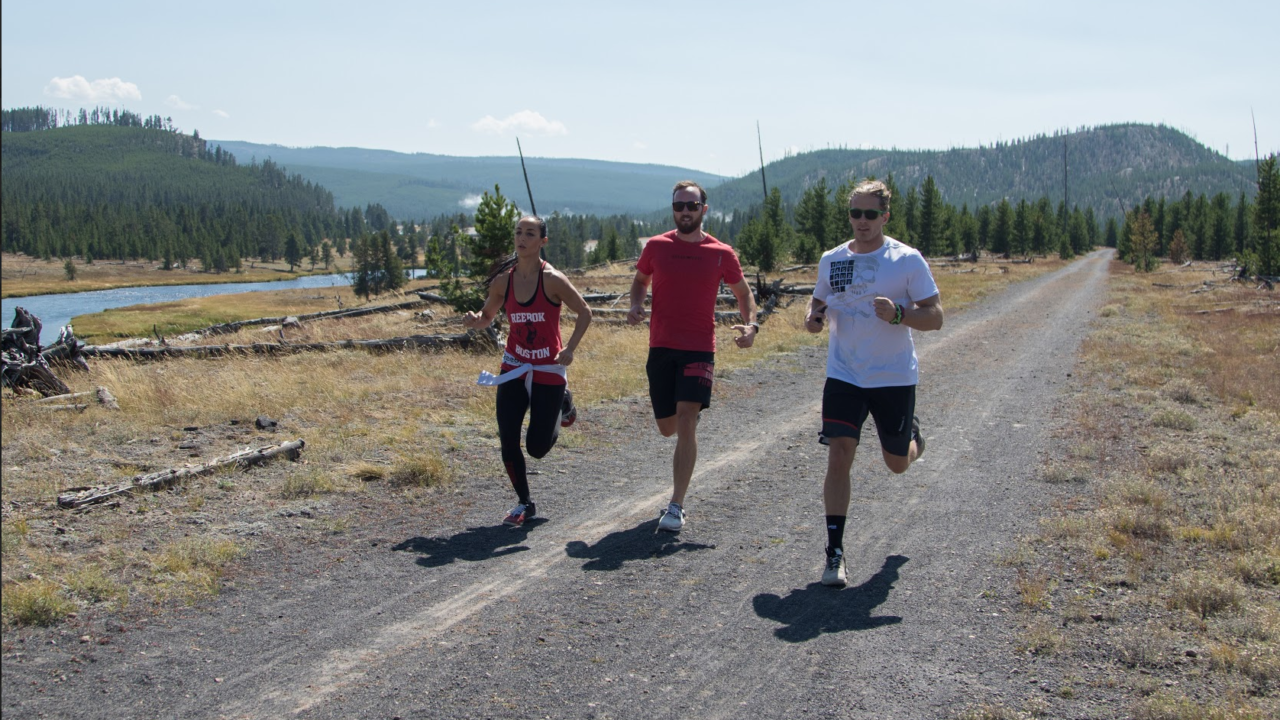
When does the body utilize fat efficiently as a fuel, and should you be consuming more fats or carbs when it comes to running nutrition?
Great questions.
Sorry folks, but the reign of pre-race pasta dinners, breakfast cereals, and post-run pancakes maybe be coming to an end. Actually, it already has.
This very informative post on fat burning and “metabolic efficiency” (ME for short!) comes straight from Ph.D., metabolic-efficiency-training-specialist, sports nutritionist, ultra runner, and Ironman Isabelle Nadeau.
You may have heard the saying, “abs are made in the kitchen” before. Fun fitness fact aside, it’s actually more true than you think, because your sit-up and core routine can never outrun your carb-induced belly.

Yup, the muscles are there—you just can’t “see” them. In fact, all the running in the world can only take you so far on its own. Food is fuel and the fuel you use has a big effect not only on how you run, but what your body looks like doing it!
Do you want to improve your run splits, high-intensity exercise tempo runs, half marathon, and marathon PRs? How about optimizing your body’s ability to run faster for longer periods? Want to train for your marathon and ACTUALLY lose weight? You’ll be surprised by the number of people who fuel incorrectly during their marathon training, experience weight gain in the process, and crash HARD on race day as a result.
It’s not the running, but the eating that needs attention!
6 Tips to Improve Your Metabolic Efficiency
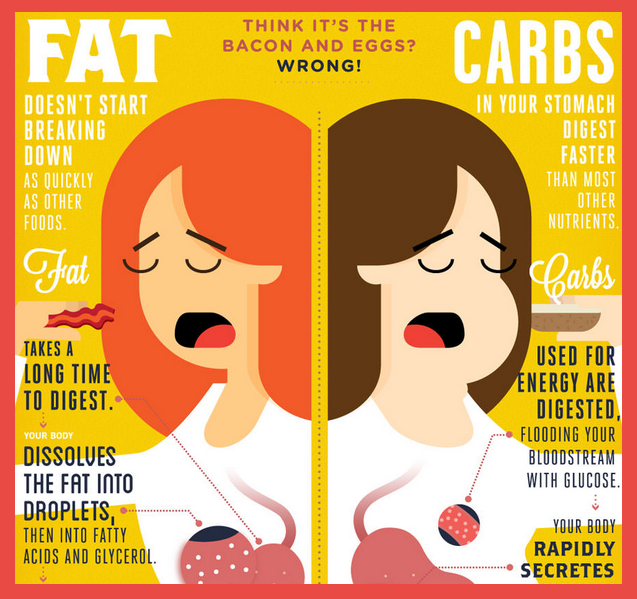
Your body learns to burn what it’s regularly fed. So, if you’re fueling your body mostly on fat your body will adapt and burn more fat. But if you use carbs as a source of fuel for physical activity, that’s what your body will go to first!”
Before we get too far, let’s first define *Metabolic Efficiency (ME for short) so we are all on the same page:
Metabolic stands for metabolism, i.e. all the chemical reactions your body (and it’s composite cells) performs to live (and to run). Efficiency is the ability to accomplish a task with the least amount of energy or work possible.
To put it together, metabolic efficiency stands for your body’s ability to perform at the highest level with the least amount of work needed to do it.
Think of a current hybrid (really good gas mileage) versus a 1970’s gas-guzzler (big engine, big car, TERRIBLE gas mileage) both going 60 miles an hour on the freeway. Which car will run out of gas first?
Now think of two runners running at the same speed. Both have the same size “gas tank”. One is burning more fat, and able to run at that speed for longer as a consequence while the other is burning through way more of their limited glycogen stores in the process.
Who bonks first, and which runner is the more fuel-efficient hybrid car? You guessed it, the fat-burning athlete!
The takeaway of this article? We all may start off as gas guzzlers, but we can ALL train ourselves to run like a hybrid by following these six steps.
Fat Is Fuel? I Thought That Was Carbs?
The phrase "Fat is fuel" doesn't aim to negate the well-established idea that "carbohydrates are fuel." Instead, it seeks to emphasize the understanding that our bodies can utilize multiple sources of energy, each having its own benefits and best-use scenarios.
The body's energy systems are intricate, utilizing different fuel sources based on the intensity and duration of physical activity. While carbohydrates are the primary energy source for high-intensity activities, fat becomes a predominant fuel during prolonged, lower-intensity activities, like long-distance running. Here's how:
- Aerobic Metabolism: During prolonged, low to moderate-intensity exercise, the body primarily relies on aerobic metabolism, which uses oxygen to convert macronutrients (like fats and carbohydrates) into energy.
- Fat Oxidation: As the duration of the exercise increases and the stored glycogen (from carbohydrates) begins to deplete, the body increasingly relies on fat oxidation. Fatty acids are broken down in the mitochondria of muscle cells to produce energy.
- Vast Energy Reserves: Even the leanest athletes possess a significant fat reserve. For instance, a person with just 10% body fat has tens of thousands of calories stored as fat, far exceeding the calories stored as glycogen. This makes fat a valuable energy reserve for activities like ultramarathons.
- Fat Adaptation: Some athletes follow training strategies or diets (like the ketogenic diet) to improve their body's ability to oxidize fat. The idea is to become more "fat-adapted," allowing the body to efficiently use fat as fuel and potentially preserve glycogen stores for later stages of prolonged endurance events.
- Benefits and Limitations: Using fat as fuel is advantageous because it provides a steady energy release, is abundant, and helps spare glycogen stores. However, converting fat to energy is a slower process than converting glycogen. As a result, during high-intensity phases of running where quick energy is needed, the body will still predominantly rely on carbohydrates.
- Fat and Carbs Work Together: Even during long, steady-state runs where fat is a primary fuel source, carbohydrates are never entirely out of the picture. Both fuels are used in tandem, with the balance shifting based on intensity and duration.
Why Does Fat as Fuel Matter?
Your body uses a limited fuel supply and you want to stretch that fuel for as long as you can, especially when preparing for longer endurance exercise. That’s why we want to train our body to burn it’s much larger reserves of fat stores.
Increasing ME speaks to your ability to burn more fat versus carbs at the same intensity. In other words, you train your body’s metabolism to use more fat at higher intensity exercise so that it spares its limited glycogen stores for greater efficiency. Glycogen is the sugar reserve that you have in your body and is in limited quantity.
Before we move on, a quick shout out: the Metabolic Efficiency concept was developed originally by Bob Sebohar, a renowned Sport Dietitian who works with Olympic level endurance athletes all over the world. (Check out his website for the full story).
6 ways to become more fuel-efficient!
Training: The more *trained* you are, the more fat you burn!
A recent study showed just that. They took nine pro athletes and nine recreational athletes and compared their ME for the same effort level.
Both groups consumed the same amount of carbohydrates, and the same amount of lactate was produced in the process, meaning both groups worked equally hard with the same amount of fuel.
But guess what?
The pro athletes were much faster in large part because they burned three times as much fat as their counterparts at the same level of relative intensity.
Takeaway: The longer your running career, and the more frequently you train, the more efficient your body will naturally become. So keep running (in some) quantity year-round!
Gender: Women are usually better at burning fat.
Yes, for once women have an advantage! Maybe it has something to do with carrying babies and having to rely more on our reserve to grow life when food is restricted.
Takeaway: Stay a woman if you are, become a woman if you’re not. Just kidding. Seriously though, you women are pretty awesome endurance machines!
Exercise mode: You burn more fat running than cycling.
Since running is much more of a whole-body exercise, and because you recruit more muscle but at a lower intensity for each muscle group.
Cycling, on the other hand, puts a high demand on only a few muscles–primarily your legs.
That is why you can get away with eating less during running compared to cycling even when you burn much more energy running–because running is more whole body and as a result “fat-friendly”.
Takeaway: with other sports will shift your body’s ability to burn fat a little bit. Running is one of the best activities to develop improved ME.
Fasting: When you are fasting your body burns more fat.
When you fast, you have lower blood sugar and insulin levels in your body. Insulin is known to shut down fat metabolism towards carb metabolism.
Takeaway: Work out first thing in the morning before eating breakfast!
Age: As we get older we are better at burning fat.
Yes, really. Maybe that is why older athletes often shine in ultra endurance events.
Takeaway: Running is no longer the land of the young. Keep aging, and continue to reap the rewards 🙂
Day to day nutrition: This is the big one.
Do you eat “boatloads” of carbohydrates on a daily basis or do you fuel withs more balanced meals and more fat?
Your body learns to burn what it’s regularly fed. So, if you fuel mostly on fat your body will adapt and burn more fat. But if you fuel more on carbohydrates, that’s what your body will go to first!
Fear, not racers! Even if on race day you decide to carb load because you want to go long and fast (and carbohydrates are necessary to do that), this effect won’t just reverse, you will still burn more fat and be able to spare glycogen.
Have you heard of our Fast and Fit Food Plan?! We teamed up with expert sports nutritionist, Elizabeth Inpyn, to design a plan for all you runners and athletes! Check it out!
Take away: We all love to eat delicious baked goods before and after our long runs. We all love pancakes and various breads. But these high doses of carbs will not help us become more fuel-efficient high performing runners!
Swap that scone with something more balanced: say an egg sandwich with bacon and avocado. This way you still get some carbs, but you get a greater dose of protein and fat.
Can you measure your metabolic efficiency?
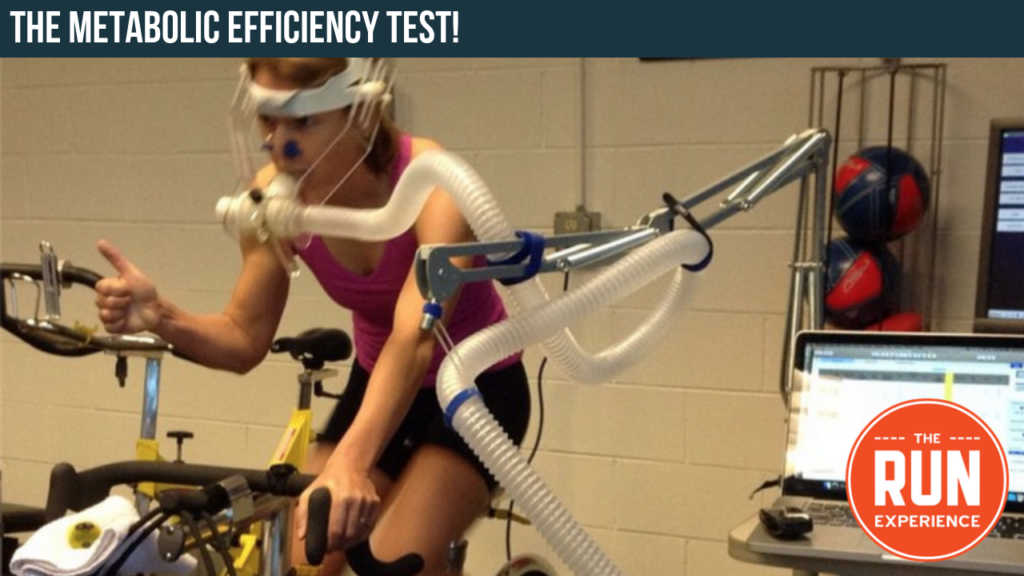
(Isabelle pictured doing a ME test!)
Yes, you can! But you need access to some equipment and preferably someone who knows how to operate it.
You can make an appointment at a lab and get hooked onto a metabolic cart. It is a machine that measures the oxygen that you breathe and the carbon dioxide that you exhale. Using an algorithm, it tells you how much fat and carbohydrate you are burning while on a treadmill or a cycle ergometer.
From there you can derive your caloric needs during training and racing at different paces. As you increase the intensity, you will start burning more and more carbohydrates.
A Tale of Two Runners
Here are two examples on the treadmill with two different athletes. Important to note that both of them report similar RPE for similar speed, but one runner is a LOT more metabolically efficient than the other.
Can you tell which one?
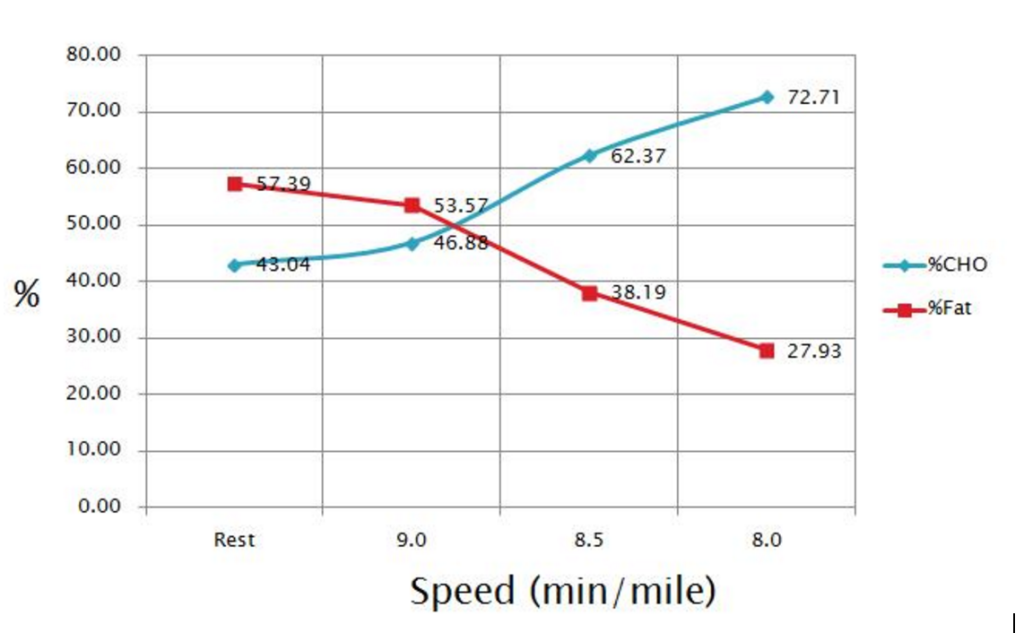
This athlete has a crossover point between 9 and 8.5 min/mile, meaning that they start burning more carbohydrates past the 8.75 min/mile mark.
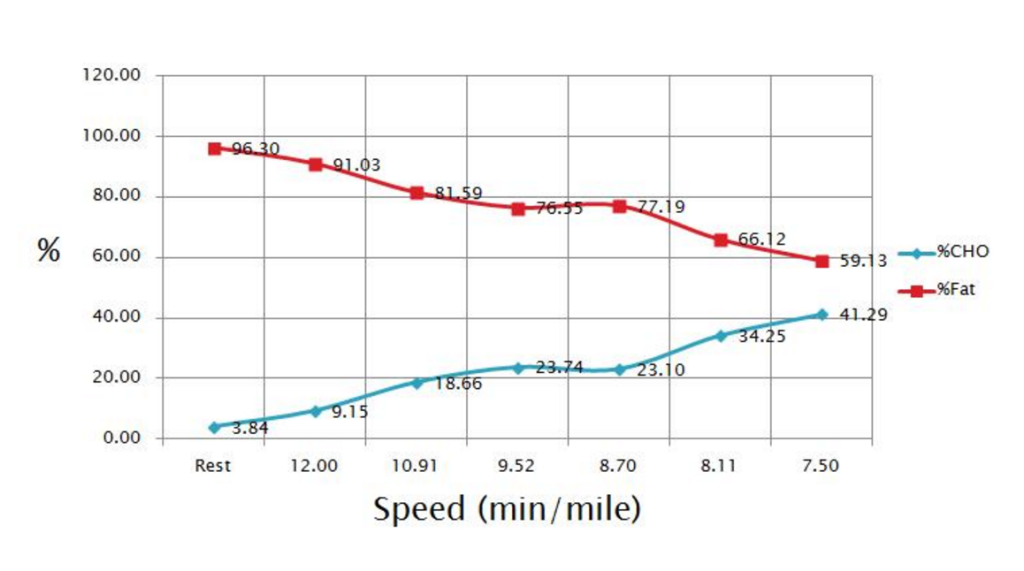
In this second example, this athlete has no crossover and is still burning more fat at 7.5 min/mile. Interestingly, this athlete burns mostly fat at rest.
Do you think that she snacks on cookies as a fuel source when working at her desk? Probably not 🙂
Two totally different pictures. Let’s do a little math and take the 8min/mile mark.
There’s a little more math here so stay with me!
First athlete:
695 kcal/hour
72% from carbs
500 kcal/hour or 125 g/hour of carbs
Approximately 30% comes from plasma glucose (from a classic paper by Luc van Loon et al. 2001)
87 g/carbs per hour from glycogen
Assuming 300 glycogen reserve, that is 3.5 hours of fuel.
Second athlete:
695 kcal/hour
34% from carbs
208 kcal/hour or 52 g/hour of carbs
Approximately 30% comes from plasma glucose
36 g/carbs per hour from glycogen
Assuming 300 glycogen reserve, that is 8.3 hours of fuel.
OK, I know, this might be an oversimplification. One caveat of this calculation is that as duration increases your body will naturally start burning more fat.
Also, we have reserves of fat stored in our muscles, and the more fat you burn the more you store. These reserves can also get depleted which leaves you with your body fat.
As you know those reserves in body fat are pretty much *unlimited* even for the leanest athlete. But how easily can you access those reserves? It can be more challenging, especially when untrained and not training in the right zones.
We also start to fatigue quickly when our glycogen reserves are depleted, so for the first athlete that could be at the ¾ of the race or at mile 21 in a marathon at 8 min/mile pace. Does “hitting the wall” sound familiar?
Overall, this is just to show you the advantages of ME for endurance events. There are other advantages such for your health, your energy levels, and your stomach.
Does Fat as Fuel Work for Everyone?
Most people report feeling great when they train their body to use fat as fuel: less sugar craving, less bonking, less eating during training and as a big result less GI (stomach) distress.
But remember, everyone will adapt differently based on run history, gender, eating habits, age and current fitness levels. You can certainly lower carbohydrates too much and create a major problem for yourself too so make gradual adjustments.
How do you know if you’ve gone too far? You become cranky, you’re not recovering, and everything looks like a doughnut. Listen to your body! And remember that you still need carbohydrates, especially for long endurance events and yes even for shorter, high intensity races.
It’s just the timing of said carbohydrates that’s key.
And remember, if you really want to know exactly how efficient you are, consult with a good sports dietician or nutritionist trained in ME and take an ME test!
Are you feeling FIRED UP but still lacking that guidance you need to get you where you want to go? Our Run Fitness Formula is the perfect place to get pick and choose strength, mobility, technique, and specific running workouts designed to work together and get you to level UP! Click HERE to learn more.
Finally, be sure to download our new, improved mobile app for access to new workouts each week and tons of training videos and resources!

